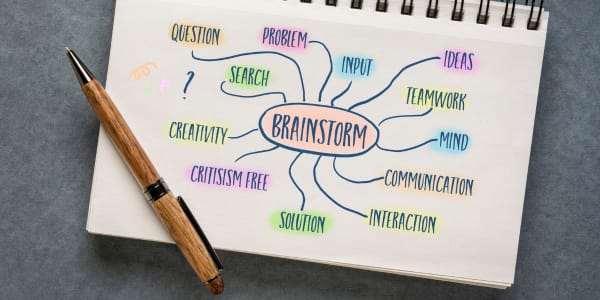How An AI Lesson Plan Generator Can Transform Your Teaching
Discover the power of AI in education with our free lesson plan generator. Streamline planning and focus on teaching!
Essential cookies are required for our site to function. If you consent to analytics cookies, please click "Accept".
These cookies are necessary for the website to function and cannot be switched off.
These cookies allow us to analyze site usage to improve our website.

Let’s be honest: scribbling down lines of dry, uninspired text isn't exactly thrilling, and it rarely helps you actually remember what you’ve learned. But the good news is there’s a more exciting way to capture and process information: the Scribble Study Method.
This creative approach to note-taking doesn’t just keep you awake during lectures; it taps into your brain’s natural ability to connect and visualize ideas. The Scribble Study Method is a game-changer for students, visual learners, educators, and professionals alike.
Let’s discuss how the scribble study method can transform your note-taking and boost your learning potential and making studying something you actually look forward to.
The Scribble Study Method combines visual note-taking with structured creativity, turning your notes into engaging, memorable tools for learning.
Originating from the timeless tradition of doodling, the Scribble Study Method takes casual sketching and transforms it into a strategic approach to information retention.
Remember those doodles in the margins of your notebooks?
Turns out, they were more than just a way to pass the time—they were your brain’s secret for memory retention. The scribble method for memory retention leverages this natural inclination, adding layers of meaning and context to your notes.
The Scribble Study Method is a whole different ball game. Here’s why this learning method is shaking things up and making study sessions not only bearable, but actually fun.
Forget about endless highlighting and monotonous re-reading. The scribble study benefits include enhanced memory retention and recall. When you engage in creative note-taking, your brain forms stronger connections with the material, making it easier to remember and recall information when you need it.
Who knew that a few doodles could spark such creative genius? The doodle learning method encourages improved creativity and lateral thinking, helping you see connections and solutions that you might have missed with traditional notes. By breaking away from rigid structures, you allow your mind to wander, explore new ideas, and think outside the box.
The Scribble Study Method turns studying into an interactive experience. By actively engaging with the material through drawing and visual representation, you’re not just passively absorbing information; you’re actively participating in your learning process. This leads to better understanding and retention of the material.
Studying can be stressful, but it doesn’t have to be. One of the most overlooked benefits of the Scribble Study Method is stress reduction through creative expression. When you incorporate doodling and creative elements into your notes, you’re giving yourself a mini mental break. This not only makes studying more enjoyable but also helps to reduce anxiety and improve overall well-being.
You don’t need a suitcase full of supplies—just some basics:
Quality Paper: A sturdy notebook or loose sheets that can handle a bit of artistic flair.
Pens and Pencils: Different colors and thicknesses add variety to your notes.
Highlighters and Markers: Perfect for emphasizing key points and creating visual hierarchies.
 From Pinterest
From Pinterest
Sticky Notes and Tabs: Great for adding layers of information and quick references.
The heart of the scribble study method is in its simplicity. Start with these basic visual note-taking strategies:
Your notes should be as unique as your fingerprint. Here’s how to craft a style that suits your brain:
Here’s how to make the most of the scribble study method:
Mind mapping is the crown jewel of non-linear note-taking. Instead of writing endless paragraphs, create a visual map that connects ideas. Picture a tree where each branch represents a different concept. This method helps you see the bigger picture and understand how everything is interconnected. Plus, it’s way more fun than traditional notes.

Let’s be honest—plain, black-and-white notes can be a snooze fest. Adding color not only makes your notes look appealing but also enhances memory retention. Use different colors for different topics, underline key points, and leave ample space between ideas. It’s like turning your notes into a visual playground that your brain will love.
Who says notes have to be all text? Mix in some doodles, diagrams, and symbols. Visuals can make complex information easier to grasp and remember. Think of it as turning your notebook into a hybrid of a textbook and a comic book. It’s not just about writing words; it’s about creating a visual story that sticks.
Sometimes, a picture really is worth a thousand words. Using visual metaphors and analogies can simplify difficult concepts. For instance, if you’re trying to understand a complicated process, draw it as a flowchart or a series of steps. It’s like giving your notes a creative twist that makes learning a breeze.
Have you ever tried visualizing the complexities of cell mitosis or the vast expanse of a historical timeline with plain old notes?
The Scribble Method for memory retention can transform this boring task into an engaging, colorful, and highly effective learning experience.
Understanding complex scientific processes and structures can be daunting. But with the Scribble Method, you can turn these abstract concepts into vivid, memorable visuals. By sketching out cellular processes, chemical reactions, or anatomical structures, you make the information more tangible and easier to recall.
History is a web of interconnected events and ideas. The Scribble Method allows you to map out these connections creatively, making it easier to see the big picture. Draw timelines that highlight significant events, scribble key concepts in the margins, and watch as the past comes to life in a way that mere text could never achieve.
Mathematics can feel like a foreign language with its symbols and equations. The Scribble Method helps bridge the gap by illustrating each step of a problem-solving process. Whether it’s a complex algebraic equation or a geometry proof, sketching out the steps makes it easier to follow the logic and retain the solution.
Learning a new language involves more than just memorizing words; it’s about understanding and retaining them. With the Scribble Method, you can create visual associations for vocabulary words, making them stick in your memory. Draw little doodles next to new words, color-code grammar rules, and turn your notes into a vibrant linguistic landscape.
So, you think you can't draw? Join the club. Many people shy away from creative study techniques because they believe their artistic skills peaked with stick figures. But guess what? The Scribble Study Method isn’t about creating museum-worthy art. It’s about making your notes visually engaging and easier to understand. Even the simplest doodles can trigger memory and boost comprehension. So, toss that self-doubt aside and grab a pen—your notes are about to get a whole lot more interesting.
Striking the right balance between detail and simplicity in your notes can feel like walking a tightrope. Go too detailed, and your notes turn into a chaotic mess. Too simple, and you risk missing key information. The trick is to capture the essence without getting lost in the weeds. Think of your notes as a map — highlight the landmarks and don't worry about drawing every single tree.
Let’s be honest — between classes, work, and life, who has time to create elaborate notes? The good news is that the Scribble Study Method doesn’t have to be time-consuming. In fact, with practice, it can save you time by making review sessions more efficient. Start with a rough outline and add creative elements as you go. The goal isn’t perfection but progress. By integrating these creative study techniques into your routine, you’ll find a rhythm that works for you, making your study sessions more productive without taking up your whole day.
Most people think digital note-taking is just tapping away on a keyboard. But turning your scribbles into digital gold is where the magic of creative study techniques comes in. Let’s start with the tools. Apps like Notability, OneNote, and GoodNotes can help transform chaotic doodles into organized masterpieces. These tools let you draw, write, and even record audio — all in one place. No more flipping through pages or losing precious insights in the void of your backpack.
Enhancing your digital notes is easy. Use different colors and shapes to create visual cues that’ll help you find key concepts. Organize your notes by topic, and don’t forget to take advantage of those search features — because you’ll definitely want to find that genius idea from your last study session later on!
Instead of everyone zoning out while one person drones on, let’s say you’ve got a group actively scribbling ideas down, bouncing thoughts off each other. This note-taking method is a dynamic process that turns every participant into an active contributor. It’s brainstorming on steroids, with each scribble sparking new ideas and deeper insights. You’ll be amazed at how quickly the collective creativity flows when everyone’s engaged in a visual conversation.
With the Scribble Method, sharing and interpreting notes becomes an enlightening experience. Each person’s unique visual style adds a fresh perspective, helping you see concepts in ways you never considered. It’s like having a multi-angle view of a complex idea, making it easier to understand and retain information. Plus, it’s a great way to ensure everyone’s on the same page—literally.
The magic of the Scribble Method shines when you start building on each other’s visual ideas. One person’s doodle can become the foundation for another’s elaborate diagram. It’s collaborative learning at its finest, where every scribble adds value and brings the group closer to mastering the subject. This approach not only makes learning more enjoyable but also fosters a deeper sense of connection and teamwork.
With its unique blend of creativity, engagement, and effectiveness, the Scribble Study Method is a powerful tool for enhancing your study sessions. So, whether you’re facing a daunting exam, tackling a challenging project, or simply trying to remember a list of vocabulary words, embrace the scribble! Transform your notes into a canvas of creativity and watch your learning soar.
By incorporating these techniques, you’ll not only make studying more enjoyable but also improve your overall academic performance. The Scribble Study Method is not just a way to take notes; it’s a way to revolutionize your learning experience.
Discover the power of AI in education with our free lesson plan generator. Streamline planning and focus on teaching!
The chunking study method is a game-changer for learning. This technique is backed by cognitive science and can revolutionize how you retain information.
Discover science-backed strategies to ace exam season without stress. Learn effective study habits, boost brain power, and master exam-day techniques.
Explore the Quizgecko platform and create your first online quiz, test or assessment. No credit card required.